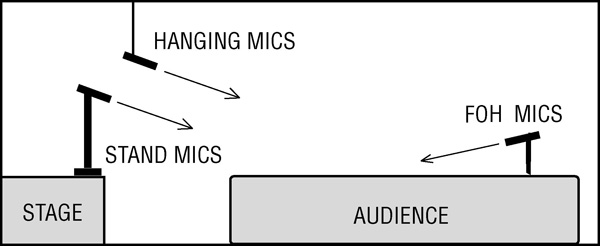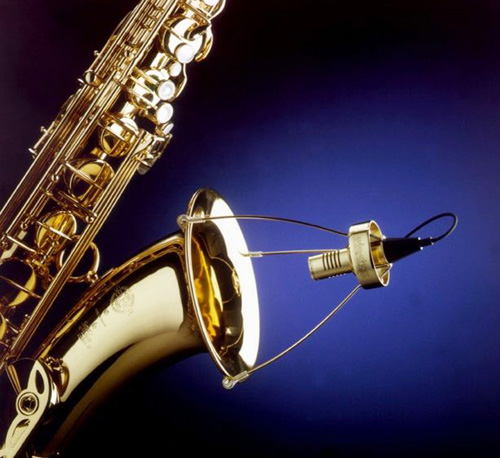
Fiddle/violin. Some mini mics are specifically designed for violin. Another approach is to use a cardioid dynamic or condenser about 6 inches over the bridge.
Mandolin, bouzouki, dobro, lap dulcimer. A flat-response cardioid condenser about 6 to 8 inches away from a sound hole is often the best option.
Saxophone. Mount a shock-mounted cardioid on the instrument bell (Figure 4). Or, try a mini omni or cardioid condenser clipped to the top of the bell, picking up both the bell and tone holes a few inches away.
Brass. Place a ribbon or cardioid dynamic about 8 inches from the bell, or attach a mini gooseneck mic to the bell.

Woodwinds. Use a flat-response cardioid condenser placed 8 inches from the side – not in the bell.
And again, a clip-on mic from a source such as AMT is another approach.
Flute. Try a cardioid with a foam pop filter near the mouthpiece, or, use a mini omni clipped on the instrument resting about 1.5 inches above the zone between mouthpiece and tone holes.
Harmonica. A very closely placed or handheld (literally) cardioid dynamic is usually the way to go.
Accordion, concertina. Employ a cardioid about 8 inches from the tone holes on the piano-keyboard side. Tape a mini omni near the tone holes on the opposite side (because it moves).
Audience. This is an interesting one! It can be done with two spaced cardioids on the front edge of the stage aiming at the back row of the audience (Figure 5).

Another method is the use of two spaced cardioids hanging over the front row of the audience, aiming at the back row.
Or, try two mics at front-of-house. To prevent an echo between the stage mics and FOH mics, slide the waveform of the FOH mics to the left (earlier in time) until it aligns with the waveform of the stage mics.
In other words, look for high signal peaks and align them in time.
Keep in mind that each of these techniques involves some compromises in order to fight background noise and leakage, but with some careful placement and EQ, they can put you well on the way to a quality recording.
More articles by Bruce Bartlett on PSW:
Recording Microphone Techniques To Produce Warm, Spacious Stereo
Remastering Jazz Classics: The Dave Brubeck Quartet, Art Pepper, and Sonny Rollins
Deconstructing Hip-Hop To Hear How The Mix Comes Together
